 |
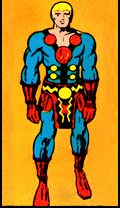 |
|
THE
ETERNALS, SHANG-CHI &
SPIDER-MAN
BACK
TO BACK IN A
NOVEMBER
1976 MARVEL MULTI-MAGS
|
|
|
|
| |
|
| |
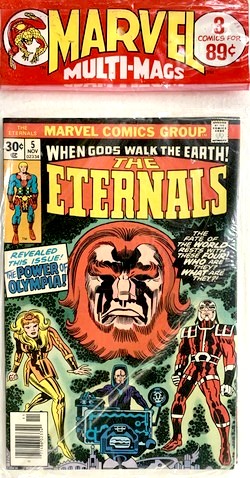 |
|
ETERNALS #5
MASTER OF KUNG
FU #46
AMAZING
SPIDER-MAN #162

|
|
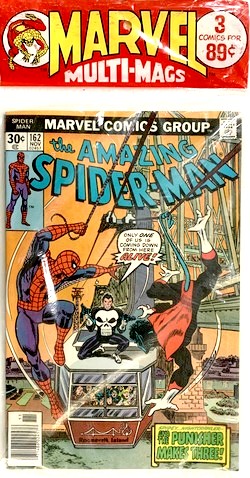 |
|
| |
|
| |
MARVEL
MULTI-MAGS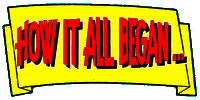 |
|
Even in the early
1960s, the comic book industry
realized that in spite of the
hugely successful comeback of the
superhero genre (which had been
clinically dead for most of the
1950s) and the subsequent streak
of new creativity and enthusiasm
it generated, its traditional
sales points were fading away.
Small stores that had carried
comic books were pushed out of
business by larger stores and
supermarkets, and newsagents
started to view the low
cover prices and therefore tiny
profit margins comics had to
offer as a
nuisance. Many ideas on how
to turn these developments around
were put forward by different
publishers, but the most
successful concepts strived to
open up new sales opportunities
and markets and thus tap into a
new customer base.
|
|
|
|
| |
| One place
these potential buyers could be found was the growing
number of supermarkets and chain stores. But in order to
be able to sell comic books at supermarkets, the product
would have to be adjusted. |
| |
| Handling
individual issues clearly was no option for these
outlets, but by looking at their logistics and
display characteristics, DC Comics (who came up
with the Comicpac concept in 1961) found
that the answer to breaking into this promising
new market was to simply package several comic
books together in a transparent plastic bag. This
resulted in a higher price per unit on sale,
which made the whole business of stocking them
much more worthwhile for the seller. The simple
packaging was also rather nifty because it
clearly showed the items were new and untouched,
while at the same time blending in with most
other goods sold at supermarkets which were also
conveniently packaged.
|
|
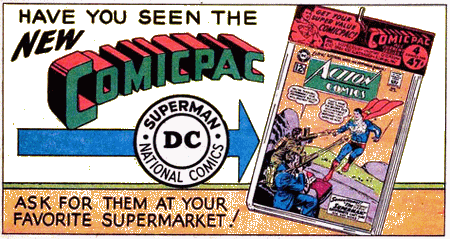 |
|
| |
| Outlets were even supplied with
dedicated Comicpac racks, which enhanced the
product appeal even more since the bags containing the
comic books could be displayed
on rack hooks in an orderly and neat fashion. |
| |
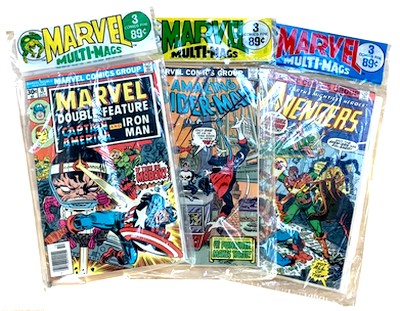
|
|
DC's
pioneer "comicpacks" were a
success - so much so that other
publishers quickly started to copy it.
Marvel produced a series of Marvel
Multi-Mags in 1968/69 but then seems
to have dropped the idea again.
However, by the
mid-1970s, the House of Ideas had
once again fully embraced the marketing
concept of selling multiple comic books
packaged in a sealed plastic bag to a
customer base which comic books could
hardly reach otherwise: people shopping
at supermarkets and large grocery stores.
It didn't really
matter therefore that buying these three
comic books in a comicpack for say 89¢
(rather than from a newsagent for 90¢ in that case) clearly presented no
real bargain - it was the opportunity and
convenience to pick up a few comics at
the same time parents and adults did
their general shopping.
Neatly packaged, it
almost became an entirely different class
of commodity.
|
|
|
| |
|
| |
| The comic books contained in this
specific MARVEL MULTI-MAGS are all
from the November 1976 cover date run, which meant that
they were actually on sale at newsagents in August 1976 -
although there could be quite a delay in terms of actual
availability of MARVEL MULTI-MAGS
at some sales points, resulting in Multi-Mags on display
that contained "semi-recent books (typically
about nine months old)" (Brevoort, 2007).
Considering the packaging and distribution process, this
doesn't really seem too surprising. |
| |
| No titles had
permanent slots in the MARVEL MULTI-MAGS, but both Amazing Spider-Man and Eternals
would show up in a reliably regular way. Issues
of Master of Kung Fu, on the other hand, have only featured in three
of the 250 MARVEL
MULTI-MAGS known
to date. But even with the
fairly regular titles (other examples were Hulk,
Avengers and Fantastic Four) there was
never any guarantee of an uninterrupted flow of
consecutive issues - and therefore a distinct possibility
of missing out on a part of the storyline. On top of
this, the continuity of the Marvel Universe of the 1970s
was such that plots and storylines usually evolved over
more than one issue. This didn't exactly make the MULTI-MAGS an ideal way of getting your
Marvel comic book fix. On
the other hand, this was a common fate of the average
comic book reader in the 1970s, whether his or her comic
books came packaged in a plastic bag or as single issues
from a display or spinner rack. Back in those days, an
uninterrupted supply of specific titles was, quite
simply, not guaranteed. Not worrying too much about
possible gaps in storylines thus became something of a
routine - besides, you would usually get a recap of
"what happened so far" on the first page.
So all in
all it simply was a part of being a comic book fan in the
1970s - as were the monthly Bullpen Bulletins (which were
the responsibility of the editor-in-chief) and the
in-house advertising.
|
| |
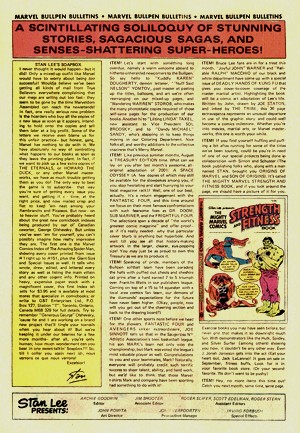 |
|
| In November 1976, the
Bullpen Bulletin was still on its way
through the alphabet as far as its title
was concerned, arriving at the letter S -
which resulted in the typically
alliterative and somewhat nonsensical
title "A Scintillating Soliloquy
of Stunning Stories, Sagacious Sagas, and
Senses-Shattering Super-Heroes!". The headline item of
Stan Lee's Soapbox column was
the kind of story that makes you wonder
(these days, not back then) how much
actual fact it contained. Were hoarders
really buying "all the copies of
a new issue as soon as it appears (...)
and sell them later at a big profit",
or were "True Believers
everywhere (...) complaining that our
mags are selling out too fast"
related more to a distribution problem?
Whatever it was, it certainly allowed
Stan Lee to throw in a plug for Marvel's
subscription offerings - which also
happened to be the subject of a full-page
in-house ad.
|
|
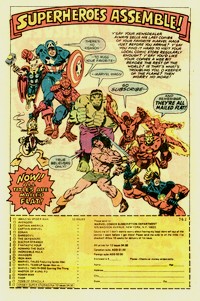
In-house ad from Eternals #5
|
As for the
actual Bullpen Bulletins' various
ITEM!
bullet points, they were - as usual - mostly
concerned with staffers new and old, plugs for
upcoming Treasury Editions, and a push for
another collaboration with Simon & Schuster
(albeit a slightly oddball one in the form of The
Mighty Marvel Comics Strength & Fitness Book).
|
|
| |
Marvel was selling its brand and properties left,
right, and centre, and doing comparatively well
(certainly in comparison to their main competitor, DC
Comics). Sales of comic books were up, dipping only
slightly during the second half of the year - but still
in overall positive territory compared to 1975, whereas
DC's numbers were only going one way, and that was down
(Tolworthy, 2016). But the bottom line would be that "running
a comic book company was no cake walk in 1976",
as Joe Brancatelli famously put it in one of his monthly
columns for Warren in 1977.
"Whatever improvements
were made at Marvel [in 1976] came by virtue of the
fact that they raised comic prices, made additional
non-comic sales (...), cut printing costs by lowering
the print runs and subsequently had less books
returned unsold since less were printed in the first
place. (...) The company decided to print less comics
in 1976 rather than trying to sell more."
(Brancatelli, 1977)
The fact that "our mags
are selling out too fast" may thus have been
caused more by a curbed supply rather than a surging
demand (which no doubt is what readers inferred from Stan
Lee's statement).
|
| |
| |
|
| |
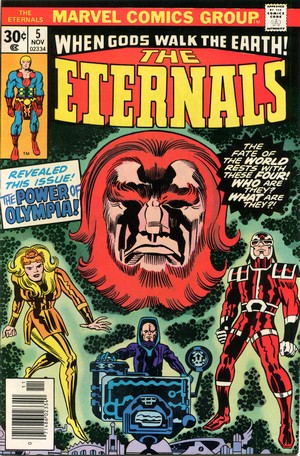
|
|
ETERNALS
#5
November 1976
(monthly)
On Sale: 10 August 1976
Editor
- Jack Kirby & Archie Goodwin
(consulting)
Cover - Jack Kirby (pencils) & Frank
Giacoia (inks)
"Olympia" (17
pages)
Story
- Jack Kirby
Pencils - Jack Kirby
Inks - Mike Royer
Lettering - Mike Royer
Colouring - Glynis Wein
STORY
OVERVIEW - Having been
informed by fellow Eternal Sersi of the
Deviant attack on New York, Makkari and
Thena, daughter of the Prime Eternal
Zuras, leave the eternal city of Olympia
to help Earth. Just as Sersi and Margo
Damian are captured and readied to be
taken to the Deviant's undersea kingdom
of Lemuria, Makkari and Thena swoop in
and take out several attackers. At the
same time, officials at the Pentagon
review the surveillance photographs taken
in the Andes Mountains of the Celestial
God-Ship.
|
|
|
| |
|
| |
| In their very own way,
the Eternals were a fun read for most of the
time, and Jack Kirby's artwork gave it a very
distinctive look. In terms of storyline, however,
the title could be a real mouthful. But in order
to fully understand the Eternals, one needs to
understand the enormous amount of Jack Kirby's
personal and professional history tied into this
title. Kirby left
Marvel Comics in 1970 for DC Comics, increasingly
angered by what he perceived to be an intentional
and continuous denial of credit for his share in
creating much of the Marvel Universe. DC promised
him not only full credit but also full artistic
freedom, the result of which was Kirby's
"Fourth World" meta-series, a blend of
classic mythology and science fiction. For some
it was the ultimate comic book saga, while to
others it just all seemed too convoluted and
confusing, and the latter group of people seemed
to be in the majority as Kirby's work didn't sell
near as well as DC needed it to (Stump, 1996).
|
| |
|
| As the number of cancellations of
Fourth World titles grew, so did Kirby's
disappointment with DC, and after his contract
ended in Spring 1975 Jack Kirby once again went
to work for Marvel. In return for this industry
scoop, "the King" essentially just
wanted to be left alone to write and edit his own
stories with no co-plotters or tie-ins with other
titles done by other people, keeping his work
deliberately detached from Marvel continuity
(Gartland & Morrow, 2013). In terms of new concepts,
Kirby started working on The Eternals,
which was thematically similar to his DC work
(especially the New Gods) but actually
took its core inspiration from Swiss author Erich
von Däniken's Chariots of the Gods - in
which the author made the both fascinating and
controversial claim that Earth had been visited
by aliens in the past and that evidence of this
could be found in artefacts and the mythologies
of ancient civilizations.
Working on this premise,
Kirby postulates such an alien visit in our
prehistoric past. Through genetic
experimentations these "Celestials"
create three distinct species: Earth's humans,
the "Deviants" (whose genes are so
unstable that every one of them is grotesquely
different and they all have lived on the bottom
of the ocean for centuries), and the
"Eternals" (undying and beautiful
humanoids with superhuman mental gifts).
|
|

Jack
Kirby
(1917-1994)
|
|
| |
| It was another typically
high-flying Kirby concept, accompanied by artwork of
complex machinery, but at least to start with it seemed
to work well enough. By the time Eternals #5 hit
the news stands, Kirby was still somewhat building his
cast and plotting out the general theme, and the letters
page was full of praise for the first two issues. |
| |
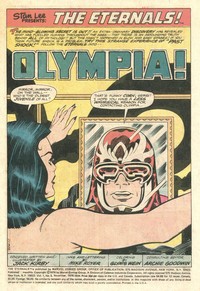 |
|
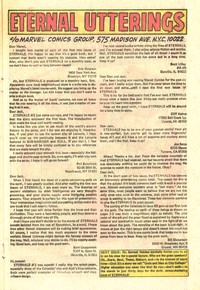 |
|
Generally speaking (although
obviously a matter of taste), a certain
"looseness" seemed to plague Kirby's
work since his return from DC. His plotting would
sometimes go off in more directions than most
readers were willing to accept let alone care
for, and even his artwork at times showed signs
of letting up, as the arguably bland and
simplistic splashpage of Eternals #5
would seem to indicate (bearing in mind that the
splashpage of any comic book was the second most
important selling point after its cover). Ultimately, his work came
across as being too detached from what the
average reader would expect. And since Marvel
Comics had always been about finding "the
formula that sells", this became a problem,
aggravated by the fact that by that time Kirby
was living and working in California and the
Marvel offices were in New York. Communication
was slow, and it seems that opinions on Kirby's
work started to drift apart significantly - some
still admired it, while others simply couldn't
stand it (Gartland & Morrow, 2013)
|
|
| |
| Only one letter published in Eternals
#5 headed in that direction, but the call to connect the
Eternals to the rest of the Marvel Universe got louder
and louder everywhere else - not the least from editorial
staff at the House of Ideas. |
"In addition
to disliking the dialogue (which was
sometimes ludicrous but always earnest, as in
the scene [from Eternals #5] when an innocent
bystander ran through crowded metropolitan
streets yelling "Run! Run! The Devil's
come back from space with an army of
Demons!"), they wanted more renowned
Marvel heroes in the book." (Ro,
2004)
Kirby only halfheartedly
tried to appease his critics, such as explaining
the presence of the Hulk in a later issue as an
instance of an android robot. This only
frustrated his critics more, but there were also
actual problems, as Scott Edelman (who as
Assistant Editor had the task of proofreading
Kirby's material) points out.
"I was
genuinely horrified by the clunky captions
Kirby was providing and the wooden dialogue
he was putting into the mouths of his
characters. I also recognized that it had
probably always been that way, that [Stan]
Lee had been able to add a veneer of
verisimilitude over Kirby’s images which
had pulled it all together in the past, that
could have done the same in the ’70s if
the relationship between the two men
hadn’t imploded." (Edelman,
2012)
Gartland & Morrow
(2013) claim that such critical reception of
Kirby's work was partly fabricated by people
inside Marvel wanting to bully Kirby out.
|
|
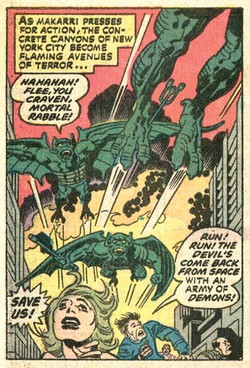 |
|
| |
Howe (2012) on the other hand quotes an unnamed
Marvel staffer who wrote positive "fan letters"
to try and counter-balance all the negative feedback
pouring in - and Edelman himself is also quite clear in
refuting the claim.
"I never tried to
usurp Kirby’s role as the scripter of the books
he drew, and I never tried to get him fired (...) as
far as I know, none of the other assistant editors
attempted to unseat the King either (...) I have to
wonder whether some Kirby supporters are so certain
in their cause that they are invested in the idea
comics fandom could not possibly have grown
dissatisfied with what Kirby was doing without Marvel
staffers surreptitiously egging them on. Isn’t
it possible that fandom soured on Kirby’s prose
on its own, with no need for a whispering campaign to
urge them to do so?" (Edelman, 2012)
On the up side, Kirby still
managed to infuse his art with a certain dynamic, and if
you liked his 1950s horror title monster work, the
visuals of the "demons from space" in this
issue looked and felt like a very pleasant throwback.
|
| |
 |
|
But regarding his scripts, an
increasing amount of corrections of dialogue made
in NYC (with Kirby only finding out when he saw
the printed copies) made the situation more and
more difficult. When Eternals
#5 hit the newsstands in August 1976, Kirby's
contract renewal was still a good 18 months out,
but when it finally came up for discussion in
April 1978 (three months after Eternals
would be cancelled with
issue #19), Stan Lee made it clear that he
only wanted Kirby's artwork and no more of his
scripting (Howe, 2012).
Not surprisingly, Kirby
left, went to work for the animation industry,
and never returned to Marvel again.
|
|
| |
 |
|
Copies
of the Eternals
appeared frequently in MARVEL
MULTI-MAGS, and although
the evidence available at this
point in time continues to
present some holes in the data,
Marvel's MULTI-MAGS may
even have carried a complete and
full run of all 19 issues. With a
little bit of luck, readers had
certainly been able to pick up
the previous issue,
Eternals #4, and
thus continue reading the story
of the Deviants' attack on NYC. |
|
|
|
| |
| |
|
| |
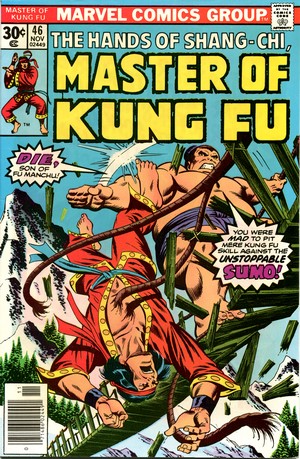
|
|
MASTER OF
KUNG FU #46
November 1976
(monthly)
On Sale: 10 August 1976
Editor - Archie
Goodwin
Cover pencils - Al Milgrom
Cover inks - Jack Abel
"The
Spider Spell!"
(17 pages)
Story - Doug Moench
Pencils - Paul Gulacy
Inks - Pablo Marcos
Lettering -
Joe Rosen
Colouring - Petra Goldberg
STORY
OVERVIEW - (Part
2 of 6; each issue is narrated by
a different character, this one
by MI6 agent Clive Reston) Reston
is captured, and Shang Chi must
get past a man-mountain of a sumo
wrestler who can resist the most
powerful Karate blows. Meanwhile,
Fu Manchu is taking further steps
for his return.
|
|
|
|
| |
| Master of Kung Fu was
one of Marvel's many titles of the 1970s which moved
somewhat outside of the traditional superhero theme. The
intention was for the House of Ideas to potentially tap
into new readership groups or expand the interests of
existing ones by opening up new genres. Star Wars is
of course the best known and also the most profitable
such venture, along with Conan the Barbarian,
but Master of Kung Fu was pretty successful too. |
| |
Marvel had started to fully
embrace the genre expansion by the very early
1970s, and the case for a Kung-Fu themed title
was brought up by Steve Englehart and Jim Starlin
after having seen the TV show Kung Fu (Pearl,
2012).
"We went to
Roy Thomas, Marvel's Editor-in-Chief, and
proposed our series. Roy was not impressed;
martial art was not his thing. But he was at
least intrigued by our enthusiasm, so he did
his [Editor-in-Chief] thing and said he'd
okay it if we incorporated Fu Manchu, a more
traditional Asian character, as a sales draw
(...) I'd read all the Fu Manchu books, and I
liked pulp. I could write Fu Manchu - if he
absolutely had to be in the book. Jim and I
didn't think he did (...) but Kung Fu was
still just a blip on the radar, and editorial
decisions are based on what's worked before,
so Fu Manchu was in." (Englehart,
2016)
|
|
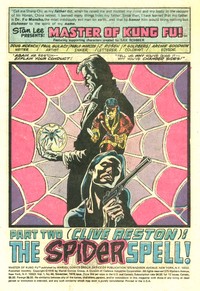 |
|
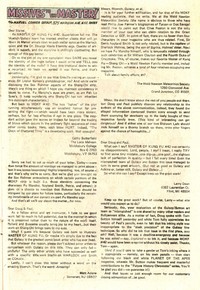 |
|
| |
| Acquiring the rights to Sax Rohmer's
characters came with a short-term sales boost and
a long-term problem. The sales boost worked
instantly. Shang-Chi made his debut in Special Marvel Edition #15
(December 1973), a former reprint title,
and resonated so well with readers that
Special Marvel Edition was
simply retitled as of issue #17, becoming Master
of Kung Fu (with the prefixed tagline The
Hands of Shang-Chi and the fan-favourite
acronym MOKF). It ran for 109 issues
before being cancelled with Master of Kung Fu
#125 in June 1983.
|
|
| |
| The long term
problem was that while Shang-Chi was a Marvel
character, Fu Manchu was not. Created by Sax
Rohmer for his 1913 novel The Mystery of Dr.
Fu Manchu (released in the US as The
Insidious Dr. Fu Manchu), the character and
name had to be licensed from the Rohmer estate. A
major reason for doing so, it seems, is that Roy
Thomas at the time had been told that DC might
look into a Fu Manchu title if Marvel did
anything in the way of Kung Fu (Cronin, 2019). However, when
Marvel cancelled the series, they lost the rights
to Fu Manchu (as was the case with many
characters Marvel licensed in the 1970s, e.g. Godzilla). It
created a problem for Marvel's own Shang-Chi
(since so much of his character background
was tied up in the relationship with his evil
father), making further appearances of the
"Master of Kung Fu" somewhat
complicated and leading to various retcon
measures in attempts to not have to use the name
Fu Manchu.

In essence, Master of
Kung-Fu and the adventures of Shang-Chi were
penned in an action and espionage adventure vein
(which also put them very much in tune with
Rhomer's later original Fu Manchu books), whilst
remaining true to Englehart's vision of a
spiritual and philosophical (and thus reluctant)
warrior who never wavers in fighting his father's
evil schemes.
But what was therefore
totally impossible for the longest time, was for
Marvel to reprint any of the original Master
of Kung Fu material - until a licensing
agreement was once again reached with the Rohmer
estate in 2015. As a result, Marvel rushed the
entire Bronze Age MOKF material to the printers
and published it in four volumes of Omnibus
format collections between 2016 and 2017.
|
|

Even
though actually only appearing in very few panels
of this issue of MOKF and not actually mentioned
by name, Fu Manchu is an essential part of the
plot - a fact that prevented reprints for
decades.
|
|
| |

Steve
Englehart (*1947)
|
|
Clearly one of the Marvel comic
books of the early 1970s where writers and
artists were aiming at an audience in the teenage
and older age range whilst using literary
characters, it enjoyed a smiliar success as Tomb
of Dracula.
"A
lot of us back then were trying to break out
of comics just for kids, and it was very
possible for us to do those things on the
non-superhero books, because no one was
paying attention. So Roy Thomas could do that
on Conan, Steve [Englehart] could do that on
Doc Strange and Master of Kung-Fu, [Steve]
Gerber could do it on Man-Thing or Howard the
Duck, and I could do it on Dracula."
(Marv Wolfman
in Siuntres, 2006)
"After
just two issues, the series was such a
sensation that [Special
Marvel Edition]
officially became MASTER OF KUNG FU (...)
Shang Chi became Marvel's most popular
character for years thereafter (...)
Unfortunately, doubling my work load was
something I couldn't do with such a
philosophical book, and rather than crank it
out, I left it. This was too bad for me, but
fortunately it was taken over by Doug Moench,
who went on to work with a series of great
artists like Paul Gulacy and Gene Day to make
it one of Marvel's truly memorable
series." (Steve Englehart, AN)
|
|
| |
 |
|
This is the
second issue of a six-part
storyline culminating in Master
of Kung Fu #50, with each
issue narrated by a different
character (part 2, in this issue,
by Clive Reston). However, Master
of Kung Fu was an extremely
rare find in a MARVEL
MULTI-MAGS, so
there was no way one could have
followed that arc with what was
available over the following
months in subsequent MARVEL
MULTI-MAGS
(although you could have picked
up the previous issue,
Master of Kung Fu #45,
with a bit of luck). |
|
|
|
| |
| |
|
| |
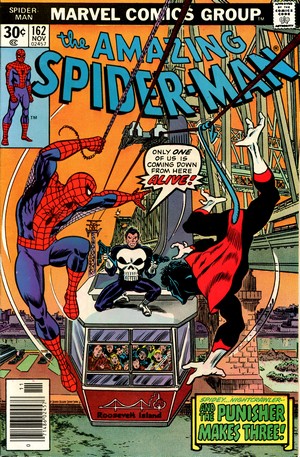
|
|
AMAZING
SPIDER-MAN
#162
November 1976
(monthly)
On Sale: 10 August 1976
Editor - Len Wein
Cover - Ross Andru (pencils)
& John Romita (inks)
"Let
the Punisher fit the Crime!"
(18 pages)
Story - Len Wein
Pencils - Ross Andru
Inks - Mike Esposito
Lettering - John Costanza
Colouring - Glynis Oliver
STORY
OVERVIEW - The
Punisher tracks down Spider-Man
and Nightcrawler, believing that
one of the heroes framed him as
the Coney Island sniper. After an
all-out brawl, the Punisher and
Spider-Man agree to team-up to
uncover the truth behind the
shootings, and they succeed in
revealing the true identity of
the gunman, who turns out to be
the villain Jigsaw, seeking
revenge for the fact that the
Punisher caused his facial
disfigurement. And J. Jonah
Jameson is seeking to have yet
another go at a Spider-Slayer.
|
|
|
|
| |
| Whereas DC's highly
structured approach to their comicpacks resulted in
zero duplicate titles across different bags, the same
could not be said for Marvel's Multi-Mags, and late 1976
was an especially chaotic period in that sense - with
numerous identical titles packaged into different
Multi-Mags of the same month. |
| |
| For the October 1976 run of
Multi-Mags there are no less than three
documented instances of duplicates packaged into
different packs: Eternals #4 (Amazing Spider-Man #161, Doctor Strange
#19, Eternals #4)
Eternals #4 (Thor #252, Eternals #4,
Captain America #202)
Daredevil #138 (Daredevil #138, Ka-Zar
#18, Marvel Spotlight #30)
Daredevil #138 (Double Feature #18,
Daredevil #138, Marvel Super-Heroes #60)
Marvel
Spotlight #30 (Daredevil #138, Ka-Zar #18, Marvel
Spotlight #30)
Marvel Spotlight #30 (Master of Kung Fu #45,
Tomb of Dracula #49, Marvel Spotlight #30)
But in
November 1976, Amazing Spider-Man #162
topped them all - being packaged into no less
than three different Marvel Multi-Mags (which is
why it is discussed in more detail here).
|
|
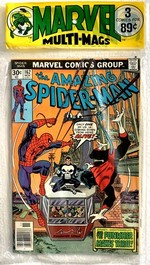 |
|
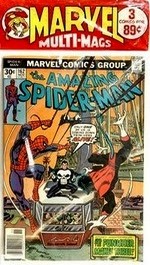 |
| |
|
|
|
|
|
|
| |
A packaging policy of this kind didn't alienate the
targeted market base much (such as parents or
grandparents buying a small treat for their kids or
grandchildren), but it didn't win any favours with the
actual comic book readers - if the problem of ending up
with duplicates for issues purchased elsewhere was
already a concern, then getting multiple copies of the
same issues in different comicpacks of the same month
really was bad news.
"I had so many
comics, the odds were I'd wind up with dupes (...)
that was why Comicpacs did not work for me."
(Evanier, 2007)
Things would not improve much in
that respect throughout 1977; the situation was even
complicated a bit by the fact that Whitman Publishing
would start putting out their own 3-packs, with
(obviously) no regard for the contents of Marvel
Multi-Mags available at the same time. It simply was just
another fact of life for comic book aficionados of the
1970s.
|
| |
| |
|
| |
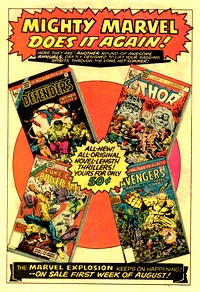
In-House
ad from Eternals #5
|
|
|
|
| |
|
| |
BIBLIOGRAPHY
| |
| |
| BRANCATELLI
Joe (1977) "The Comic Books",
in Creepy #92 (October 1977) BREVOORT Tom
(2007) "Marvel Multi-Mags", Blah Blah
Blog, originally published online 28 April
2007, reposted 18 April 2020
CRONIN
Brian (2019) "Did Marvel Have a License for Fu
Manchu Before Shang-Chi Was Created?", published online at CBR,
27 May 2019
EDELMAN
Scott (2012) "Revisiting Jack
Kirby’s return to Marvel Comics", Scot Edelman
Blog, published online 27 May 2012
ENGLEHART
Steven (AN) "Master of Kung Fu", Steve
Englehart Writes, published online (date
unknown)
EVANIER
Mark (2007) "It's
in the Bag!", published online in News
From Me
GARTLAND Mike
& John Morrow (2013) "You can't go home again - Kirby's
1970s return to the "snake pit" of
Marvel Comics",
in Jack Kirby Collector #29
HOWE
Sean (2012) Marvel Comics - The Untold Story,
Harper Collins
PEARL Barry
(2012) "Lost in Licensing: Exit Fu Manchu", published online at Comic
Book Collectors Club, 27 June 2012 (accessed
through archive.org)
RO
Ronin (2004) Tales to Astonish - Jack Kirby,
Stan Lee, and the American Comic Book Revolution,
Bloomsbury
SIUNTRES
John (2006) "Marv Wolfman by Night", Word
Balloon: The Comic Creator's Interview Show
(transcribed from the podcast originally
available online at wordballoon.libsyn.com)
STUMP
Greg (1996) “Infantino Raises
Questions About CBG Letters Policy Following
Kirby Controversy Flare-Up”, in The
Comics Journal #191 (November 1996)
TOLWORTHY
Chris (2016) "Marvel
and DC sales figures",
published
online at zak-site.com
|
|
| |
| |
|
| |
| |
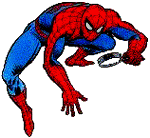

(c) 2023
uploaded to the web
15 October 2023
|
| |
|
 |
|






























